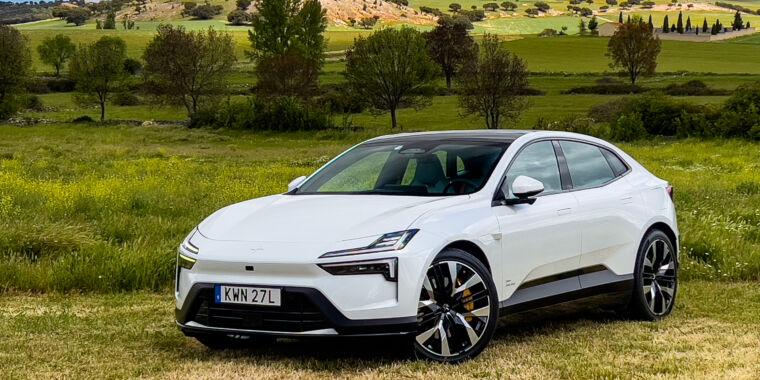Jonathan Gitlin
“If you’re going to make a car and use all that energy, it should be a good car,” said Thomas Ingenlath, CEO of Polestar. Ingenlath was referring to the company’s latest electric vehicle, a midsize SUV with striking coupe looks called the Polestar 4. While Ingenlath is on point from a sustainability perspective, it makes good business sense, too. The Polestar 4 needs to be a good car to stand out as it enters one of the most hotly contested segments of the market.
In fact, Polestar uses less energy to make its latest EV than anything else in its range—the company quotes a carbon footprint of 19.9 tonnes of CO2 from cradle to gate. Like some other automakers, Polestar is using a monomaterial approach to the interior to make recycling easier, choosing the same base plastic for all the components in a particular piece of trim, for example.
The carpets are made from, variously, recycled fishing nets or plastic bottles. The vinyl seats use pine oil instead of the stuff extracted from the ground, and the knitted upholstery fabric—also recycled plastic bottles—was designed to leave no off-cuts.
-
The headlights are a Polestar trademark now, even though there have been just four models so far.
Jonathan Gitlin -
Coupe-like looks, SUV-like practicality.
Jonathan Gitlin -
No, your eyes don’t deceive you, there is no rear windshield.
Jonathan Gitlin -
The interior is inspired by sportswear.
Jonathan Gitlin -
The back seat of the Polestar 4 outdoes rivals from Porsche, BMW, Audi, and Mercedes-Benz.
Jonathan Gitlin -
At night, LEDs illuminate the interior from behind textile trim panels. The colors are switchable depending on which theme you have the car set to—more on that later.
Jonathan Gitlin
The fastest Polestar yet
In addition to being the greenest Polestar so far, this one is also the most performant. We tested the Long Range Dual Motor version, which can send up to 536 hp (400 kW) and 506 lb-ft (686 Nm) to the wheels. Pick this version and you should see 270 miles (434 km) from the 100 kWh battery pack. In a suitable location like a motorway toll booth, 60 mph arrives in 3.7 seconds (100 km/h in 3.8).
That’s if you’re in performance mode, at least. Switch to range mode, and clutches disconnect the front permanent magnet synchronous motor and remap the throttle pedal for better efficiency. There’s also a heat pump as standard. The car can DC fast-charge at rates of up to 200 kW, which should take the battery pack from 10 to 80 percent state of charge in 30 min. At home on an 11 kW AC charger, 0–100 percent SoC should take about 11 hours.
There is also a Long Range Single Motor variant with precisely half the power and torque but an EPA range of 300 miles (482 km). Driven by just its rear wheels, the Polestar 4 has more modest performance—60 mph arrives in 6.9 seconds, 100 km/h in 7.1—but it also carries a $10,000-cheaper price, starting at $64,900. New tariffs on Chinese-made EVs are to blame for the hike, but Polestar told Ars that it will honor the original pricing for customers who had already placed orders. Next year, production of US-market Polestar 4s will begin in South Korea, which will mean significantly smaller import tariffs.

Jonathan Gitlin
It’s surprisingly good to drive
It has to be said: Making an electric car go fast is not particularly difficult. Electric motors generate most of their torque almost immediately, and unlike with a combustion motor, if you increase the peak power, there isn’t really an efficiency hit lower down the performance envelope. So even a 3-ton monster can get hurled down the road rapidly enough to embarrass a whole lot of supercars.
The Polestar 4 isn’t quite that heavy—5,192 lbs (2,355 kg)—so it forgoes air suspension in favor of conventional coil springs and dampers. These are passive in the Single Motor, but the Dual Motor is equipped with active dampers as standard, and if you choose the performance pack, it’s upgraded with stiffer springs and antiroll bars and new damper tuning.
Our test car was so equipped, and it was a noticeably firm ride, particularly when sitting in the back. There was also a bit of wind noise at speed, but more tire roar, thanks presumably to the performance pack’s 22-inch wheels.


